PARALLEL CURVE OF A CURVE
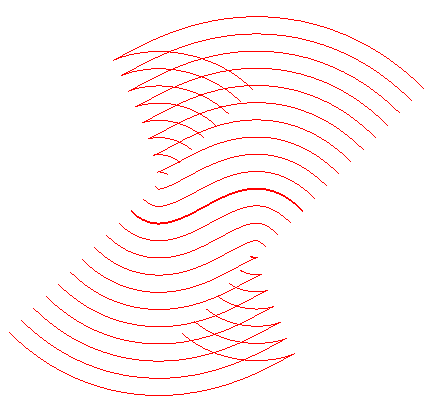
| next curve | previous curve | 2D curves | 3D curves | surfaces | fractals | polyhedra |
PARALLEL CURVE OF A CURVE

| Notion studied by Leibniz in 1692. |
| The curves For an initial curve Cartesian parametrization: The parallel curves of an algebraic curve are algebraic. Curvilinear abscissa at the current point on  . .
Radius of curvature: The length of an arc of The area of the strip included between two corresponding arcs of |
Two curves are said to be parallel of one another if any curve normal to one is normal to the other; it can be proved that, then, the distance between two points with common normal is a constant, called parallelism distance. Do not mistake with the image of a curve under a translation.
Two curves are therefore parallel to one another if they are the loci of the ends of a segment line of constant length moving perpendicularly to its direction, which is equivalent to saying that the line carrying this segment rolls without slipping on its envelope.
See also at reptoria the generalisation of parallel curves by the crawling motion of a circle on a curve.
As well as for lines, the parallelism relation of plane
curves is an equivalence relation.
An equivalence class is the set of all trajectories of
points linked to a line rolling without slipping on a curve ; the moving
line is the common normal line to all the parallel curves, and the fixed
line is the common evolute
to all these curves.
The parallel curves of a curve are therefore the involutes
of its evolute.
|
The involute presenting (in general) a cusp at a point
of the starting curve, the evolute appears as the place of the cusp points
of the parallel curves.
|
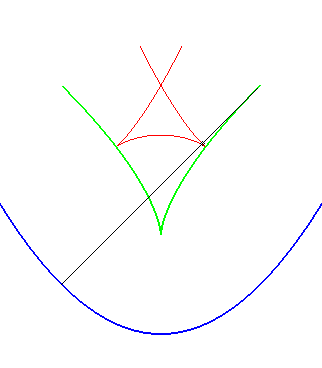 |
The parallel curves of a curve
are the curves
,
parallel of index a of
,
obtained by algebraically copying a "length" a from the points on
on the oriented normal; in other words, they are the loci of the points
M
=
where
is the normal vector at M0. Since
the parallelism relation is symmetrical,
is also parallel to
.
The reunion of
and (G-a)
is the envelope of the circles
with radius a centred on
;
therefore, it is also the visible outline of a tube,
the bore of which is projected along
.
If the curve
is placed on a plane in a motion of circular
translation with radius a with respect to a fixed plane, then the
envelope in the fixed plane is, again, the reunion of
and
.
The parallel curves of a curve
can also be considered as the plane contour lines of an equal
slope surface with directrix
.
Physical interpretation: if the curve
is a light source, according to the Huygens principle, the "wavefronts"
are the envelopes of the elementary circular wavelets emitted by all the
points on the curve
;
they are therefore exactly the curves parallel to
.
The singularities of parallel curves describing the evolute of the initial curve, with the previous physical interpretation, the evolute therefore represents the place where the light rays emitted by the curve are concentrated.
Examples:
- the curves parallel to a line are
the lines parallel to this line (!)
- the involutes
of a curve are parallel to one another.
- the toroids
are the parallel curves of the ellipse
- the Cayley
sextic is one of the parallel curves of the nephroid
- The parallel curves of the parabola
x²
= 2p y are the curves parametrized by:
| Opposite illustration of the construction of the two parallels at given distance to the parabola, by envelope of a circle whose center describes the parabola (not plotted in the figures), or by envelope of "circular translated"of the parabola. | 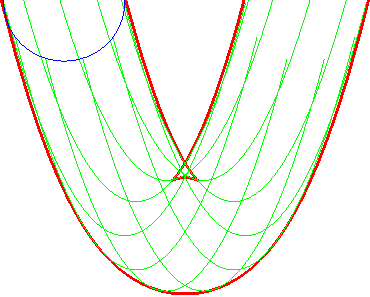 |
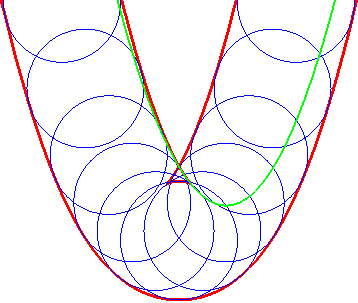 |
- It can happen that the curves
and
are
equal. Then, the curve
is parallel to itself at distance 2a.
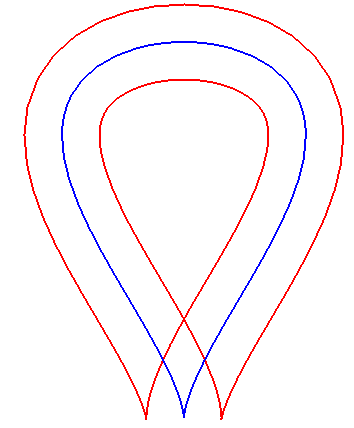 |
The red curve is parallel in two ways to the blue curve, and self-parallel. |
A similar notion is the notion of contour line of the function "distance (of a point on the plane) to the curve", called distance curve (or line). These contour lines are composed of portions of parallel curves and arcs of circles, and are interesting because they form a partition of the plane, as opposed to parallel curves.
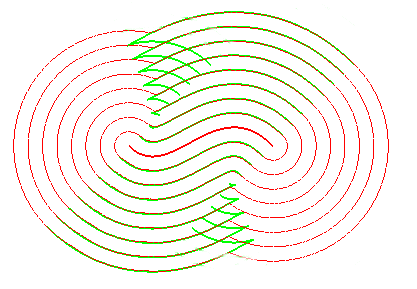
In green, the parallel curves, and in red, the contour lines of the
function "distance to the curve"; when they do not coincide, the latter
are composed of arcs of circles.
See also the 3D
parallel curves and the parallel
surfaces.
| next curve | previous curve | 2D curves | 3D curves | surfaces | fractals | polyhedra |
© Robert FERRÉOL 2019